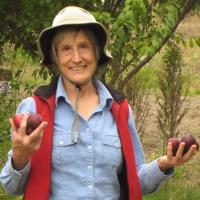![]()
|
Donna Haraway Finds Connections in the Stories |
Listen |
|
|
|
Connections |
[Once the audio is playing, click and drag across the volume bars to change volume. Initial volume set to 80%.] |
|
Donna Haraway is a member of the Gleaning Stories project team. She sat down with Rusten and recorded some of her reflections on the connections she finds between the stories of gleaners and about the connections the gleaners themselves make with their lives, their food, and each other. |
||
|
The Senses: Flavor Bursts Donna reflects on gleaners connecting with the tastes, smells, and textures of foods; with the squishiness of the mud in the fields; in short, with bodily pleasure. |
||
|
Service, Charity, Poverty, and the Right to Food Starting with some reflections on the call to service that so many gleaners express, Donna contrasts the call to charity with a more political analysis of hunger as the result of poverty. She recalls the history of gleaning, the enclosure and privatization of the commons, and the growth of modern agriculture to explore our acceptance of systematic hunger and poverty as natural fact. It would be a real mistake, she says, to draw too clear a line between religious and secular expressions of service ... but, she says, Susan Harding will have much more to say on that. | ||
|
Experience The appeal to experience in the gleaning stories is common. But the appeal takes different forms depending on how removed gleaners feel from farms and fields. Gleaners who have only seen the field workers from their cars have a different relationship to the work ("wanting to know what it's like") than do those who grew up on farms or who have done field work themselves. Donna also reflects on the status of farm work in different gleaners' stories. |
||
|
Who Has the Land? Several gleaners and managers told stories of changing ownership of the land. The Tanimura & Antle story of the Anglo family keeping a Japanese family's land in trust for a Japanese family interned during WWII was a story of holding onto land. Other gleaners told stories of families losing control of their land, having to lease the land, or of the end of family farms in the Midwest (or S. Korea). Still others, like the gleaners who grew up on family farms in Maine, tell of lasting connections and the persistence of family farms there. |
||
|
Boundaries Lots of stories spoke to boundaries. Donna starts by remarking on the ritual quality of the gloves, hairnets, and sterilized knives we gleaners don or take up and the imprecations rained down on those who might want to take food or water into the fields. Though she understands the liability issues involved, she contrasts the call to purity with real risks. She makes similar comparisons between large produce buyers demanding monocropping from their organic growers, even though multicropping and species diversity makes far more biological sense. She notes the call to purity that demands that growers not harvest within a certain radius of any bird droppings and that they prevent human and wilder-life from entering fields. |
||
|
Labor Many gleaners, particularly men, were eager to talk about the changing labor processes and tools/machinery of cannery work, refrigeration, or field practices. Partly this reflects the historically gendered nature of agriculture and food processing work. She concludes with a few remarks on containerization at all scales of produce collection and transportation. |
||
Note: If you have any trouble using the audio buttons on this webpage, please let us know.
![]()

![]()

![]()

Partially Funded by the California Council for the Humanities, UC Santa Cruz, and INTA - TrainingWeal.

